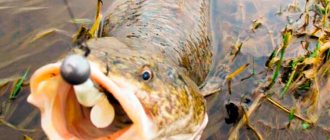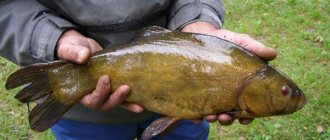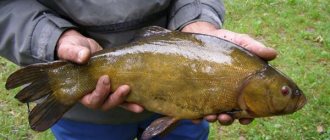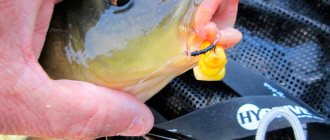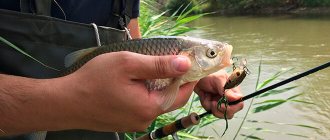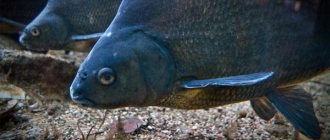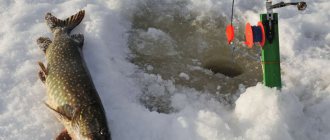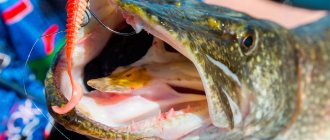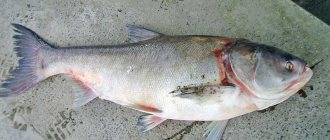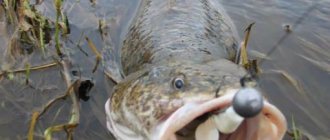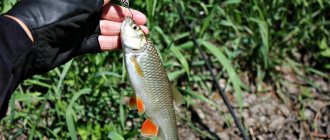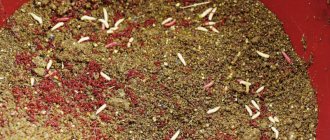Interest in silver carp among fishermen is growing every year, and fishing is popular with almost any gear. The fish is of impressive size and has tasty meat, but before you go fishing, it is important to study the parking areas, fishing techniques and tactics, nutrition, applicable baits and baits, taking into account the hunting season.
Catching silver carp is not easy; you need knowledge and skill. We will consider the main secrets in the form of step-by-step instructions in this article.
Description and behavior characteristics
Silver carp is a valuable commercial fish. It is found in schools mainly in fresh waters, preferring to feed on phytoplankton and algae. It is difficult to confuse an aquatic inhabitant with other inhabitants due to some features in appearance and behavioral habits.
In silver carp:
- silver body;
- big head;
- high forehead;
- small eyes located slightly below the mouth.
The ponds of China are considered the homeland of silver carp; it used to be called “Chinese silver carp.”
By species, hybrid, bigheaded and silver carp are distinguished:
- Whites prefer to live in muddy greenish water, constantly cleaning it of detritus and feeding on phytoplankton.
- Variegated individuals feed on zooplankton and river vegetation. They live up to 20 years, reaching 1 meter in length.
- Hybrid, bred by breeders, are considered the most common type of commercial fish. They are distinguished by the presence of a large head covering almost half of their body and feed on zooplankton. They go to spawn late (closer to July), when the water temperature is no lower than +20°C. Hybrid silver carp are voracious and are considered caretakers of overgrown reservoirs, because in short periods of time they can destroy all algae, thereby improving lakes and reservoirs. Average weight is 4-5 kg upon reaching 4 years of age.
White
Motley
Hybrid
Fish are rarely seen on the surface of the water. When the temperature drops below +8°C, it goes into the depths of the water and the bite stops. Although you can often see splashes on the water when the fish jumps out of the water, making loud sounds.
In winter, silver carp goes into sleep, preferring deep holes in the reservoir. Thanks to reclamation features, heat-loving silver carp have now acclimatized to our Russian conditions. They are found in the waters of different regions of the country, growing up to 2 meters in length and weighing up to 0.5 centners, eating all kinds of algae in large quantities.
In some places in Russia the climate is quite harsh and fish are not capable of reproduction. This is of particular interest to experienced fishermen. Catching a large specimen is a success, although one weighing 3-4 kg can be caught quite well.
Breeding silver carp in ponds
Silver carp breeding can be organized within two or three years. Depending on what type of system is selected. The size of the pond, its depth, oxygenation, water flow, the fish catching system designed for age categories, the size and stage of development of the fish are taken into account. Separating fish by age category prevents the spread of diseases and creates better sanitary and hygienic conditions for its breeding and growing.
The most common pond size is one that has a surface area of about 150-300 square meters and has the ability to drain water quickly and fill it with water just as quickly.
Spawning ponds are usually filled at the bottom with various types of grass to facilitate egg sticking. Spawning grounds are used in May or June for two weeks.
The first transfer of fish takes place after they have been there for 4-6 weeks, it all depends on the intensity of production. It is allowed to keep up to 800 pieces per hectare of a reservoir of common silver carp, if the annual growth is at least 1.0 kg, and 300 pieces of bighead carp per hectare with an average annual growth of 2.0 kg. The bottom of the reservoir must ensure the implementation of all necessary agricultural procedures. At first, the released fish eat only natural food (flour with winter rye) and therefore there must be the required amount of it.
In the fall, individuals are selected from a school of older fish from which they are expected to produce new offspring next year.
They are placed in a separate pond, in which they overwinter and are kept until spawning begins. Silver carp prefers hot summer sun, water temperature of 25-30 degrees Celsius and a lot of plant food, reservoirs with a muddy river bottom and soft vegetation. The silver carp sees off the sunset and meets the dawn near the coastline; during the day it prefers to be in the middle of the pond, at a depth of 2-3 meters.
Silver carp feeds on phytoplankton, while bighead carp has a more varied diet: detritus and zooplankton, so it grows much faster than white carp, and also loves and eats artificial crumbly food.
Habitats
Silver carp are found everywhere in ponds, rivers, and reservoirs where there is a lot of aquatic vegetation. They prefer reservoirs with a muddy or rocky bottom, seaweed, also in water depths of up to 3-5 meters. In summer, at dawn or in the evening, you can find them right off the coast.
Favorite places:
- shallows with slow currents;
- artificial reservoirs rich in plankton;
- sandy, clayey or rocky bottom.
You can calculate the habitat using a simple method - stick several branches of reeds in the intended fishing area. If after 2-3 days they turn out to be chewed and broken off, then most likely there are schools of fish nearby. Silver carp bite well in warm windy weather or when it is drizzling.
Breeding silver carp in a pond
There are three main types of silver carp: white (or common) silver carp; bighead carp; hybrid silver carp.
Next, we will look at each of these types separately in more detail:
Silver carp - lives in a school, is of medium size, the head makes up about twenty percent of the total mass.
The bighead carp is larger, but the head makes up half of its total mass, the color is darker than the usual silver carp, the main advantages of this species are a more extensive diet and the fastest weight gain.
Hybrid silver carp - Has absorbed the best of the two species, retaining the relatively small head size of the first and receiving a rapid weight gain (slightly lower than that of the bighead) from the second, it has also become more cold-resistant.
What to feed silver carp
Silver carp feeds on algae and phytoplankton; bighead carp eats zooplankton, so it gains weight faster; the hybrid species feeds on both phytoplankton and zooplankton.
In terms of diet, silver carp gets along very well with grass carp, they complement each other perfectly, but bighead carp competes with carp, keep this fact in mind. Silver carp also consume artificial food.
Temperature conditions and habitats:
These fish are very thermophilic; they love warm water, heated up to 25 degrees. In such conditions, maximum weight gain occurs. Reservoirs with a muddy bottom and a depth of up to 4 meters are best suited for their life. In the morning and evening, silver carp approach the shore and during the day they move further away from it.
Reproduction of silver carp:
It reaches the ability to reproduce at the age of three to five years. Spawning occurs in early summer, when the water temperature warms up to 20°C. Silver carp acquires marketable appearance after two years. The caviar is floating. Spawns on the current in places with whirlpools.
Silver carp has a high meat value, it is very tender and has excellent taste; it is consumed both fresh and frozen.
Breeding fish at home
Breeding silver carp can become a profitable business if everything is calculated correctly and correctly, we hope our article helped you. With this we say goodbye to you, we wish you good luck in breeding silver carp, until we meet again!
Biting calendar by fishing season
In each season of the year, silver carp behaves in a special way, and it is important for anglers to know the biting time in order for fishing to be enjoyable:
- Spring - the waters are filled with dendrite and algae and the silver carp begins to look for food. It is still at the bottom and only when the water warms up to +25°C does it move closer to the surface, starting to feed intensively and greedily grab any bait. At the end of May, silver carp spawn and bite well on artificial pieces of foam rubber, foam balls and even a cigarette filter.
- Summer , after the end of spawning closer to July, you can also go fishing to catch large silver carp. The bite is successful with any bait.
- Autumn. Until October, you can catch some good trophies, while there are a lot of different insects and vegetation in the area.
When the temperature drops below +8°C at the end of October, the fish begins to accumulate fat reserves to feed for the winter and the bite is quite successful on any microorganisms, plankton, which the fish greedily swallows along with the hook. The main thing is to maintain silence and camouflage when arriving at the reservoir. Silver carp are shy and cautious. If you startle them, they will immediately go into the depths of the waters and may never return. - Winter. There is practically no bite, the fish sleeps, sinking to the bottom. It prefers to sleep, and there is no bite at this time until the ice begins to melt.
Reproduction and spawning
Sexual maturity in silver carps occurs at 3-5 years of age. The mating period generally occurs in May-June, when the water warms up to 18-20 degrees. During this period, the fish look for a warmer place so that the cold does not damage the eggs.
It should be noted that the fertility of silver carp is very high. Thus, large individuals are capable of producing about 1 million eggs, and small ones - about 500 thousand. At the same time, the female always tries to lay her offspring near the algae so that they cling to them. If the water is well heated, then within a day the first fry will hatch from the eggs. Their length at birth rarely exceeds 5.5 mm.
So, what does a silver carp eat in the wild? It should be noted that this fish begins to eat 4 days after birth. It is during this period that they develop small gills, thanks to which they sift phytoplankton from the water. After the first week, the fish larvae move on to other types of plankton. And only after a month and a half do small silver carps begin to eat adult food.
Fishing methods: equipment
When choosing equipment, it is important to take into account the main characteristics: strength and strength. The silver carp has an impressive size, and at the moment of capture it will offer strong resistance, making sudden movements. Inexperienced fishermen often experience various equipment breakdowns and line breaks. You can fish using bottom and float gear.
Bottom tackle
Basic parameters for donka, usually used for mass commercial fishing:
- leash 0.4 mm in diameter;
- sharp hooks No. 8,9,10;
- rod up to 5 m in length;
- durable fishing line up to 0.5 mm in diameter.
Using bottom tackle is easy. The main thing is that it is powerful and does not break off at the moment of fishing for strong fish.
It is important to pay attention to the strength of the fishing line. Fishermen also recommend using springy feeders with a float if you have bottom gear.
When fishing in the current, place the feeders at least 6 meters from each other to avoid tangling.
Float tackle: spinning rods and carp fishing rods
Main characteristics:
- inertia-free coil;
- a fishing line with a blue float at the top and a brighter one at the top at the bottom to attract fish;
- sliding float for fixing the weight;
- a fishing rod up to 5 m in length in the form of a feeder tube with a foam ball attached;
- a powerful fishing line equipped with a weight with the ability to move back and forth depending on the depth of the reservoir;
- bead as a stopper for the float when immersed in water
- bite alarms for greater comfort when fishing.
The main attention should be paid to the feeder with plankton. You need to hammer it in such a way that the food is washed out evenly and gradually when lowered into the water surface.
Features of the “silver carp killer” tackle
The components of the “silver carp killer” tackle include:
- the float is large in size;
- a feeder with hooks by attaching it at a distance of 25-30 cm from the float;
- large hooks hanging from the end of the fishing rod to hit directly into a cloudy cloud on the water;
- a sliding sinker installed just above the float, which will serve as an anchor.
It’s not difficult to assemble such gear:
- thread the weight through the main line;
- string a float and a stopper onto the fishing line;
- attach the crusher with the bead;
- tie a silver carp stick;
- pick up a feeder (filled with technoplankton) with hooks;
- equip the tackle with a spring;
- bring the leashes out from the stick.
DIY bait recipes
It is not necessary to buy bait in the store; you can make it yourself from ingredients that can be found in every home. Various cereals and technoplankton prepared at home are popular.
To prepare the bait you will need:
- Millet – 3 kg.
- Makukha – 1 glass.
- Breadcrumbs 2 packs.
- Powdered milk – 150 gr.
You can add 250 grams of store-bought bait.
Millet is pre-divided into two parts of 2 and 1 kg. The first part should be boiled for about 15 minutes. You need to make sure that the mixture does not burn, but also avoid frequent stirring. Grind the smaller one. Leave the boiled porridge wrapped in a towel for 3 hours. Add the remaining products before fishing, mix thoroughly.
- 4 liter saucepan.
- Peas – 1 kg.
- Semolina – 2.5 kg.
- Honey – 1 tbsp. l.
Water is poured into the container and brought to a boil. Peas are poured into it, after which the gas on the burner is reduced to a minimum. Cook the porridge for approximately 4 hours. The porridge should be stirred periodically to prevent it from burning, otherwise you will have to cook it again. When the peas are ready, they should be passed through a colander. The strained broth is put back on the fire, and the peas are set aside for bait on other fish.
Pour semolina into the broth, stirring it with a spoon to avoid the appearance of lumps.
When the porridge is ready, it needs to be removed from the heat and kneaded until it stops sticking to your hands. After this, honey is added and everything is put in the refrigerator.
Technoplankton can be prepared in a similar way. There are several recipes for its preparation:
- Semolina – 500 gr.
- Corn flour – 500 gr.
- Breadcrumbs – 300 gr.
- Mamalyga – 300 gr.
- Sugar – 300 gr.
All products are mixed in a large container, and water (a small portion) with honey is added.
- Condensed milk – 1 can.
- Cake powder.
- Powdered milk.
Condensed milk is poured into a bowl and beaten with a mixer. Gradually milk and cake (half the portion) are poured in there.
You need to mix until you get a mass with the consistency of sour cream. After this, the mixture is placed in the refrigerator for 40 minutes. After removing the mass from the refrigerator, it is diluted with the rest of the milk powder and cake, adding a little water.
First stage.
- Dog food – 500 gr.
- Roasted crushed peanuts – 100 gr.
- Sweet paprika (powder) – 50 gr.
- Powdered sugar – 200 gr.
Mix all ingredients in the first bowl.
Stage two. Take another container and place the following ingredients in it:
- Boiled potatoes – 500 gr.
- Bananas – 1 kg.
- Egg yolk.
- Condensed milk – 50 mg.
Mash everything and mix with the first part to form a dough. This mass can be rolled into barrel shapes. Used as groundbait and also as bait.
The best baits and lures
Success when fishing for silver carp is ensured if the bait is delivered on time to a cloudy cloud on the water.
Silver carp prefers technoplankton , but during the spawning period such a glutton wakes up that it bites on almost everything :
- green pea;
- canned corn;
- vegetables;
- cabbage leaves;
- semolina porridge;
- crumb of bread
- young shoots of grass;
- insects, spiders;
- seaweed;
- spices;
- herbs: nettle, mint, hemp.
In a fishing store you can buy ready-made technoplankton in the form of pressed food powder, easily soluble in water. Next, prepare the mixture, adding breadcrumbs, honey, and cinnamon for flavor.
It is important to feed the fish in advance, and it is the turbidity in the water that is attractive to silver carp.
You can use foam plastic as bait, roll it into large balls up to 6 mm in diameter and fill the feeders. You can put 2-3 balls on hooks. just before lowering the fishing rod into the water. Many fishermen wrap the hooks with seaweed on top to make them more attractive.
As bait, you can crumble bread, cookies, vanilla sugar into the water, or cook porridge. The main thing is that the bait begins to release bubbles on the water, creating a cloudy cloud. All movements of the fishing rod should be smooth and gradual so as not to spook the fish.
Technoplankton for catching silver carp
The action of technoplankton is based on its constant dissolution in the water column and the formation of a feeding spot from very small particles of food. This is what attracts silver carp, since it feeds mainly on such small particles.
Technoplankton is the main food for silver carp, consisting of vegetation and algae. Some manufacturers add detritus, crustacean plankton, chironomid and macrophyte larvae, and blue-green algae to the composition. Silver carp like these baits in the form of large tablets. When dropped into water, the tablet begins to slowly dissolve, forming an attractive cloudy cloud.
The dissolution time of a tablet similar to living plankton is 2-3 hours, but it all depends on the strength of the river current and the correct placement of gear. When the fish approaches the feeding area, it will begin to clear the cloudy cloud and greedily swallow the hooks with the offered food. However, nothing should interfere; the hook should dangle freely in the water.
It is likely that immediately after casting the tackle, the fish will begin to bite, so you need to constantly be on alert in order to catch and hook the fish in time using the hook.
Ingredients for baits
Making baits is quite possible on your own at home.
The ingredients used are:
- cake;
- breadcrumbs;
- powdered milk is fine;
- whole peas;
- corn flour;
- hominy;
- vanilla sugar;
- fresh vegetation near bodies of water (clover, nettle);
- bran;
- coastal sand;
- molehill in the form of sand made from mole algae;
- starch;
- flour.
Recipes for preparing complementary foods
- You can prepare porridge at home for filling feeders or rolling balls for throwing into the water:
- take millet (1.5 kg), add water, boil for 3 hours;
- remove from heat, add flour, breadcrumbs;
- mix, form balls from the resulting mixture, throw fish into the water as bait, or fill the feeders tightly.
- Boil peas (4 kg) in 1 liter of water, strain. Pour semolina into the resulting broth and again prepare a thick porridge. Remove from heat, add honey, hominy, breadcrumbs. The porridge should be crumbly to form balls and aromatic to attract fish.
- Collect herbs near the pond: clover, nettle. Slice and add peeled cucumber. Scroll the mixture through a meat grinder. Leave for 3 hours. Add bran, coastal sand, maybe a little molehill. Knead. Feed the area chosen for fishing. Equip the hook from the fishing rod with clover and nettle leaves, and string a cucumber (slice) on top. When using bottom gear, use a foam ball.
- Mix flour with sugar, vanilla, milk powder, starch. Pour water, add sand, bran. Boil the contents until you obtain a fairly loose, crumbly consistency. Form into balls.
You need to fill the feeders directly near the river bank. If the waters are poor in natural plankton, then it is a good idea to use coastal vegetation (reeds, algae) as complementary food. When approaching the feeder, silver carp will begin to rummage, straining (filtering) small particles and swallowing large ones along with the hook.
More adult individuals weighing 2-3 kg are more interested in insects and larvae. In the summer, collecting them will not be difficult either.
Bait for silver carp - Bait secrets
It is known that in fishing one of the main components of success is bait.
For silver carp, conventional mixtures used when fishing for carp fish are not effective. This fish will not eat various porridges and store-bought baits, because the forehead fish is not accustomed to such food.
Technoplankton, which is bait, also serves as bait. Therefore he must:
- Be satisfying.
- Smell good.
- Be noticeable.
Why do we need nourishing bait?
For silver carp, like for any other fish, nutritional value is important. If the bait is ordinary “dust”, the silver carp will not linger near the equipment. Therefore, technoplankton is usually mixed using semolina. Semolina is very small, but at the same time high in calories. The lobate will eat such a treat with great enthusiasm.
The smell of bait is an additional attractive factor. Although natural plankton does not smell, silver carp willingly gravitates toward the fragrant cloud of turbidity and eats the odorous technoplankton without fear. What should bait smell like? For silver carp, it is best to use the following flavorings:
- anise;
- vanilla;
- shrimp;
- honey;
- fish platter
Well, the most important requirement is visibility.
In nature, silver carp searches for accumulations of plankton, focusing on clouds of turbidity in the water. Therefore, the bait for the lobate should become very dusty in the water, simulating accumulations of microscopic algae. If fishing is carried out using float gear, then the rocker with technoplankton hangs in the water column. The melting bait slowly sinks to the bottom, creating a column of turbidity that perfectly attracts silver carp.
However, silver carp can not be caught using float gear everywhere and not always. In some reservoirs, this fish can only be caught using a bottom fishing rod for long-distance casting, and ordinary technoplankton is not suitable for such fishing.
Fishing technique and tactics
If you have a well-assembled tackle, it is not at all difficult to catch quite a hefty silver carp by casting it in the expected biting area. The main thing is to make timely hooks, because the fish is strong and restive.
Tactics:
- First, you need to throw 1-2 portions of complementary food into the water, wait for the turbidity and many particles to float to the surface inside the cloud.
- Thread pieces of foam onto the hook to make it easier for the fish to swallow it along with food.
- Fill the feeders with bait.
- Place in water.
- Wait for bites, preferably keeping a landing net at hand.
If you scare the fish away, it is unlikely that it will return at the same time and all efforts and expectations of bites may become in vain. You need to maintain silence on the reservoir, and it is better to first find paths trodden by fish near reeds, dense vegetation, and holes.
In the selected area, immerse the reed branches in water and wait to see if the silver carp gnaws on the proposed vegetation.
If everything was successful, then you can immerse the equipment in the middle layers of water, hanging a reed leaf on a hook. If the bush turns out to be eaten away, it means that there are fish in this place. All that remains is to wait for the bites and arm yourself with a hook so as not to miss the trophy. Strength and skill when fishing, of course, will also come in handy.
Ready-made baits for catching silver carp
Specialized stores often sell high-quality baits. One of them is ready-made technoplankton. It is a pressed food powder that easily dissolves in water and forms a slight cloudiness. It contains aromatic and flavoring substances. There are several different types of technoplankton: anise, honey, strawberries, bloodworms, blood, vanilla, raspberries. Looks like a small barrel. Suitable for fishing with a bottom fishing rod.
If you want to learn how to make technoplankton with your own hands, you can learn about it from our article.
In addition, silver carp are often caught using foam balls, which are placed on hooks of 2–3 pieces. Sometimes it is possible to catch it on an empty hook, having previously wrapped it in algae.
Tips and tricks
- The best place for fishing is clean and clear water.
- For convenience, it’s a good idea to build a stand on the river bank for a float rod. The tackle itself - with an electronic device or a bell as a bite alarm.
- Keep a hook handy, because the fish can be caught large, although you don’t need to hook it, it will do it on its own.
- When purchasing technoplankton, you need to pay attention to the manufacturer. If the bait does not dissolve well in water, then fishing may go down the drain.
- Hooks should be sharp and replaced as needed. In a blunt form, they are unlikely to get caught in the fish’s mouth, and accidents are inevitable.
- It is advisable to experiment with complementary foods first. If a fish approaches a muddy cloud, splashes will appear on the water and even the silver carp themselves will jump to the surface.
- Fishing can also be ruined by a strong current, when feeders and bait are quickly carried away from the intended fishing spot. To prevent this from happening, it is better to equip the tackle with a sliding weight of up to 80-100 g. The float must withstand a load of up to 60 kg, which also needs to be thought about in advance.
- If you have a float rod, you can fish for fish from any depth, which is convenient, unlike bottom tackle.
Moreover, it is quite possible to use 2 baits at the same time: heavy and light. It is desirable that the population of the reservoir with silver carp be at least 9-10 years. But when choosing technoplankton, you should pay attention to its color. - Casting the bait should be gentle and careful. The silver carp suddenly swims up and bites. It happens that he begins to take the bait in jerks. If you are too suspicious, it can simply go deeper to the bottom.
- Immediately when you first pull the tackle, you need to prepare for the fight. The rage of the fish can be excessive. When she gets hooked, she will try to hide in the bushes and leave. You can't miss the moment here.
- Using the hook you need to quickly pull the fish towards you. The help of friends will come in handy. But the jackpot can be quite decent.
Bait for silver carp - Features of bottom fishing
Let's imagine that we have attached ordinary technoplankton for float fishing for silver carp on a bottom rig. The loaded bait will fall to the bottom, begin to dissolve, and particles of bait will immediately settle to the bottom. Not only will the silver carp not notice such bait, he will also not be able to eat it. The mouthparts of this fish are designed to take food that is at or above the level of the head. P
Picking up prey from the bottom is a real problem for silver carp; it feeds in this way only in exceptional cases. Therefore, when using bottom equipment, it is necessary that the bait does not sink, but floats up, forming a vertical column of turbidity.
How can you achieve this effect? Some fishermen add finely grated champagne or wine corks to the bait. Light, buoyant particles rise upward when they become limp and attract the attention of fish.
This method of making floating bait is very common, but not the best. A cork is not edible, it is only an imitation of an edible object. A silver carp may approach a dusty pillar, but it will not linger near it.
For a long time, fishermen were looking for a way to make bait that would generate a lot of dust at the bottom. The search for a solution led to the invention of a geyser mixture, which, when it gets into water, begins to actively dissolve and form a large cloudy cloud.
Geyser bait is made from the same components as bait for float fishing for silver carp, but two “secret” ingredients are added to it: baking soda and citric acid.
If you mix these substances dry, nothing will happen. But if this mixture is in water, a chemical reaction will immediately begin. The mixture begins to boil, hiss, release a lot of gases, etc.
Gas bubbles tend to rise upward and carry small particles of food with them.
Today geyser bait is in great demand. It is used to catch not only silver carp, but also carp, crucian bream, roach, etc.
Due to great demand, many fishing companies produce it on an industrial scale. A geyser costs approximately 100-150 rubles per package.
But, unfortunately, what you need is not always available on sale: the mixture does not stick together well, the fraction is too large, etc. Therefore, many fans of silver carp fishing make their own bait. The recipe for a catchy geyser is very simple.
Ingredients:
- Peas – 1 kg.
- Semolina – 1 package.
- Soda.
- Lemon acid.
- Any flavoring.
Cooking process:
- The first step is to soak the peas. Pour it into a container, fill it with water, and leave for 8-12 hours. The longer the peas sit in water, the better.
- Next, take a 3-liter saucepan and boil water in it. When air bubbles appear in the water, you need to pour peas into it and boil them until they are completely softened.
IMPORTANT! While cooking, stir the porridge constantly to prevent it from burning. Fish do not like the smell of burning.
After the peas are cooked, you need to take a second saucepan or large bowl and pour the viscous slurry formed during the cooking of the peas into it through a colander.- After this, you need to gradually pour semolina into the mixture, constantly stirring it with a spoon. When the mixture is very thick, you need to pour soda and citric acid into it, mixed in advance in equal proportions. If you want to give your bait additional flavor, you need to add flavoring to it.
Once again you need to thoroughly mix the entire mixture and put it in a plastic bag - the geyser bait is ready. When it is in the water, the soda and citric acid will react, and the volcano will “erupt.” Only instead of lava there will be tasty and nutritious semolina.
